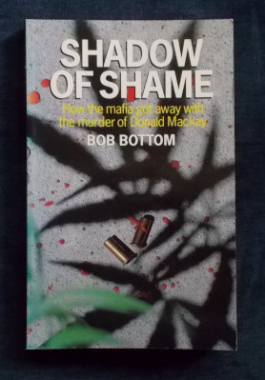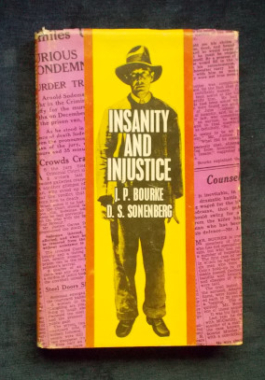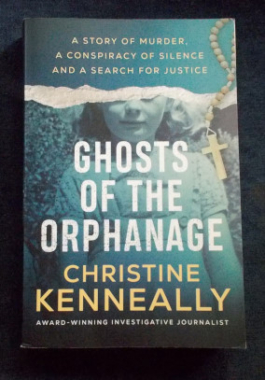-
As the world goes about its daily business, criminals and cops engage in a deadly battle of wits. This book delves into the crimes that police have to deal with day after day. Murderers, hitmen, kidnappers, and drug dealers all feature in this collection of true crime stories. Take the drug dealer who walked out of a restaurant bragging that he's killed a man—unaware that his fellow diner was an undercover policeman. Or the young mother, whose death was written off as suicide, but which subsequent investigation proved to be something much more sinister.
-

Shadow Of Shame: Bob Bottom
$12.00Donald Bruce MacKay, the Griffith anti-drugs campaigner, disappeared without trace from the carpark of the Griffith Hotel in July 1977. Mackay had been a secret informant for polce against illicit growing of marijuana growing in the Riverina area. His ‘disappearance’ became Australia’s first political assassination. This is the shocking story of how the mafia planned and executed his murder. Throughout the shameful decade that followed, some people, even at senior levels of politics and law enforcement, connived to cover up this mafia murder. Bob Bottom, a crime journalist, traces the birth and growth of the mafia in Griffith, known to police as a centre for serious crime as early as the 1930s. By the 1970s, when Mackay first became concerned about illicit drug activities in his town, those controlling organised crime had become far more sophisticated. Bribery, corruption and pay-offs had become commonplace. Serious questions about NSW police investigations into Australia’s most notorious murder precipitated a special commission of enquiry – nine years later...Bottom also details how drug boss Robert Trimbole lived safely in Spain despite international police knowledge of his whereabouts and of the failure of Australian authorities to bring him to justice. Illustrated with black and white photographs. -
 In 1982, teenager Andrew Tregurtha pleaded guilty to the murder of the Greek Consul-General and a teacher in Sydney's inner city. Six years later he committed suicide at Berrima Gaol. Between the hours of dark and daylight, the lonely hours when prisoners are locked in their cells, Andrew hanged himself. This is his own story. Tregurtha's confession confession begins with the difficulty his family experienced dealing with his undiagnosed hyperactivity and dyslexia, the ensuing confrontations with education authorities and his move to King's Cross as a fifteen year old. Here, unbeknown to his parents, he worked as a male prostitute, eventually falling under the influence of Michael Caldwell, who introduced him to the world of crime in the city. He was sixteen when he was arrested for murder. It is a harrowing tale of life on the edge, of a waif at the Cross, written simply and unglamorously, as he worked towards self-understanding and rehabilitation. Andrew too his own life before publication. Illustrated with black and white photographs.
In 1982, teenager Andrew Tregurtha pleaded guilty to the murder of the Greek Consul-General and a teacher in Sydney's inner city. Six years later he committed suicide at Berrima Gaol. Between the hours of dark and daylight, the lonely hours when prisoners are locked in their cells, Andrew hanged himself. This is his own story. Tregurtha's confession confession begins with the difficulty his family experienced dealing with his undiagnosed hyperactivity and dyslexia, the ensuing confrontations with education authorities and his move to King's Cross as a fifteen year old. Here, unbeknown to his parents, he worked as a male prostitute, eventually falling under the influence of Michael Caldwell, who introduced him to the world of crime in the city. He was sixteen when he was arrested for murder. It is a harrowing tale of life on the edge, of a waif at the Cross, written simply and unglamorously, as he worked towards self-understanding and rehabilitation. Andrew too his own life before publication. Illustrated with black and white photographs. -
 The case of Arnold Karl Soderman is one of the most remarkable in the criminal annals of 20th century Australia. No matter what angle - legal, medical or from the layman's point of view - it presents startling drama and raises challenging questions. The macabre story of the killing of four young children, one only six years old; the tragedy of two men charged with the crimes of which they were guiltless; the situation of a father confronted with an unfounded allegation of the ferocious murder of his daughter; the spectacle of honest witnesses mistakenly testifying as to the identity of an accused man so as to bring the object of their accusations within the shadow of the gallows; the fight for the life of the killer through the hierarchy of the Australian Court System up to the Privy Council; the decision to hang the accused, declared by two government doctor and another highly qualified psychiatrist to have been insane at the time of the killings; and the carrying out of the sentence all combine to make a story which calls for the telling. Co-author J.P. Bourke was Counsel for the Defence in this case 1935-1936
The case of Arnold Karl Soderman is one of the most remarkable in the criminal annals of 20th century Australia. No matter what angle - legal, medical or from the layman's point of view - it presents startling drama and raises challenging questions. The macabre story of the killing of four young children, one only six years old; the tragedy of two men charged with the crimes of which they were guiltless; the situation of a father confronted with an unfounded allegation of the ferocious murder of his daughter; the spectacle of honest witnesses mistakenly testifying as to the identity of an accused man so as to bring the object of their accusations within the shadow of the gallows; the fight for the life of the killer through the hierarchy of the Australian Court System up to the Privy Council; the decision to hang the accused, declared by two government doctor and another highly qualified psychiatrist to have been insane at the time of the killings; and the carrying out of the sentence all combine to make a story which calls for the telling. Co-author J.P. Bourke was Counsel for the Defence in this case 1935-1936 -
 In the years between 1860 and 1880, dozens of bushrangers, some bold and famous, some little more than petty thieves, rampaged across the New South Wales and Victorian countryside - looting and murdering, bailing up travellers, harassing police, terrorising settlers. Perhaps the most famous of these in the 1860s was a handsome young man named Ben Hall, the first official outlaw under a new Act, shot dead by police in 1865. Other members of his gang, "Flash" Johnny Gilbert, Johnny Vane, O'Meally and Dunn, were all captured or shot by their pursuers. Also outlawed were Frederick Lowry, the ferocious Daniel Morgan, and Fred Ward, better known throughout New South Wales as "Thunderbolt". Finally, in this second volume of his History of Australian Bushranging, Charles White examines at length the incredible story of the Kelly Gang - Ned, Dan, Steve Hart and Joe Byrne.
In the years between 1860 and 1880, dozens of bushrangers, some bold and famous, some little more than petty thieves, rampaged across the New South Wales and Victorian countryside - looting and murdering, bailing up travellers, harassing police, terrorising settlers. Perhaps the most famous of these in the 1860s was a handsome young man named Ben Hall, the first official outlaw under a new Act, shot dead by police in 1865. Other members of his gang, "Flash" Johnny Gilbert, Johnny Vane, O'Meally and Dunn, were all captured or shot by their pursuers. Also outlawed were Frederick Lowry, the ferocious Daniel Morgan, and Fred Ward, better known throughout New South Wales as "Thunderbolt". Finally, in this second volume of his History of Australian Bushranging, Charles White examines at length the incredible story of the Kelly Gang - Ned, Dan, Steve Hart and Joe Byrne. -

Jimmy Governor: Frank Clune
$30.00Jimmy Governor was born a half-caste and grew up to be a gentle, hard-working man. On December 10 1898, he committed the unpardonable sin of marrying a white woman. He and his wife, downgraded to the status of outcasts, became the targets of taunts, insults and bigotry from a society determined to undermine their dignity. Two years later, Jimmy Governor became a murderer. -
 This is the shocking secret history of twentieth-century orphanages - which for decades hid violence, abuse, and deaths within their walls. For much of the twentieth century, a series of terrible events - abuse, both physical and psychological, and even deaths - took places inside orphanages. The survivors have been trying to tell their astonishing stories for a long time, but disbelief, secrecy, and trauma have kept them from breaking through. For ten years, Christine Kenneally has been on a quest to uncover the harrowing truth. Centering her story on St. Joseph’s, a Catholic orphanage in Vermont, Kenneally has written a stunning account of a series of crimes and abuses. But her work is not confined to one place. Following clues that take her into the darkened corners of several institutions across the globe, she finds a trail of terrifying stories and a courageous group of survivors who are seeking justice. Ghosts of the Orphanage is an incredible true crime story and a reckoning with a past that has stayed buried for too long, with tragic consequences.
This is the shocking secret history of twentieth-century orphanages - which for decades hid violence, abuse, and deaths within their walls. For much of the twentieth century, a series of terrible events - abuse, both physical and psychological, and even deaths - took places inside orphanages. The survivors have been trying to tell their astonishing stories for a long time, but disbelief, secrecy, and trauma have kept them from breaking through. For ten years, Christine Kenneally has been on a quest to uncover the harrowing truth. Centering her story on St. Joseph’s, a Catholic orphanage in Vermont, Kenneally has written a stunning account of a series of crimes and abuses. But her work is not confined to one place. Following clues that take her into the darkened corners of several institutions across the globe, she finds a trail of terrifying stories and a courageous group of survivors who are seeking justice. Ghosts of the Orphanage is an incredible true crime story and a reckoning with a past that has stayed buried for too long, with tragic consequences. -

Fatty: Andy Edmonds
$12.00Many people remember Roscoe Arbuckle as 'the fat comedian who raped that girl'. He was one of the highest paid actors of his day and Hollywood was at his feet. On September 5 1921 he threw a lavish party to celebrate his $3 million Paramount contract. It got wildly out of hand and ended abruptly when a starlet named Virginia Rappé let out a terrifying scream. Rappé died five days later and Arbuckle was charged with first-degree murder . Three trials later, he was finally acquitted - and by then his multi million dollar career was devastated and his life was ruined. Recreating the glittering Hollywood of the 1920s, Edmonds draws on new and hitherto unpublished evidence to determine what really happened on that fateful day. Illustrated with photographs.


